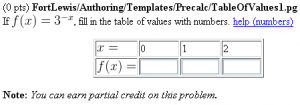TableOfValues1
Jump to navigation
Jump to search
This problem has been replaced with a newer version of this problem
Fill in a Table of Values for a Function
This PG code shows how to create a table with answer blanks in it.
- File location in OPL: FortLewis/Authoring/Templates/Precalc/TableOfValues1.pg
- PGML location in OPL: FortLewis/Authoring/Templates/Precalc/TableOfValues1_PGML.pg
| PG problem file | Explanation |
|---|---|
|
Problem tagging: |
|
DOCUMENT(); loadMacros( "PGstandard.pl", "MathObjects.pl", "AnswerFormatHelp.pl", ); TEXT(beginproblem()); |
Initialization: |
Context("Numeric");
$f = Formula("3^(-x)");
@answer = ();
foreach my $i (0..2) {
$answer[$i] = $f->eval(x=>$i);
}
|
Setup:
We create an empty array |
Context()->texStrings;
BEGIN_TEXT
If \( f(x) = $f \), fill in the table of values with numbers.
\{ AnswerFormatHelp("numbers") \}
$PAR
$BCENTER
\{
begintable(5) .
row( "\(x = \)", "0", "1", "2" ) .
row( "\(f(x) = \)", ans_rule(5), ans_rule(5), ans_rule(5) ) .
endtable();
\}
$ECENTER
END_TEXT
Context()->normalStrings;
|
Main Text:
Notice that the table is inside a Perl code block |
$showPartialCorrectAnswers = 1;
foreach my $i (0..2) {
ANS( $answer[$i]->cmp() );
}
|
Answer Evaluation: |
Context()->texStrings;
BEGIN_SOLUTION
${PAR}SOLUTION:${PAR}
Solution explanation goes here.
END_SOLUTION
Context()->normalStrings;
COMMENT('MathObject version.');
ENDDOCUMENT();
|
Solution: |
